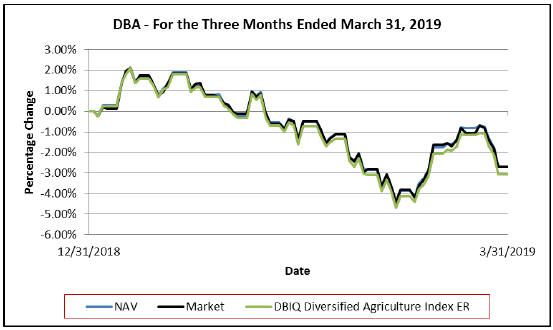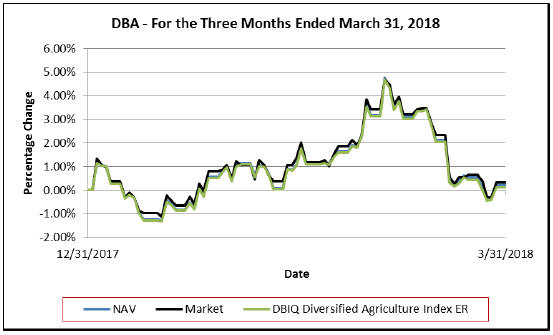The following were the primary trading risk exposures of the Fund as of March 31, 2019 by Index Commodity:
Corn
The price of corn is volatile. The price movement of corn may be influenced by three primary supply factors: farmer planting decisions, climate, and government agricultural policies and three major market demand factors: livestock feeding, shortages or surpluses of world grain supplies, and domestic and foreign government policies and trade agreements. Additionally, the price movement of corn may be influenced by a variety of other factors, including weather conditions, disease, transportation costs, political uncertainties and economic concerns.
Wheat and Kansas City Wheat
The price of wheat is volatile. The price movement of wheat may be influenced by three primary supply factors: farmer planting decisions, climate, and government agricultural policies and three major market demand factors: food, shortages or surpluses of world grain supplies, and domestic and foreign government policies and trade agreements. Additionally, the price movement of wheat may be influenced by a variety of other factors, including weather conditions, disease, transportation costs, political uncertainties and economic concerns.
Soybeans
The price of soybeans is volatile. The price movement of soybeans may be influenced by a variety of factors, including demand, weather conditions, disease, crop production, transportation costs, political uncertainties and economic concerns.
Sugar
The price of sugar is volatile. The price movement of sugar may be influenced by a variety of factors, including demand, weather conditions, disease, crop production, transportation costs, political uncertainties and economic concerns.
Cocoa
The price of cocoa is volatile. The price movement of cocoa may be influenced by a variety of factors, including demand, weather conditions, disease, crop production, transportation costs, political uncertainties and economic concerns.
Coffee
The price of coffee is volatile. The price movement of coffee may be influenced by a variety of factors, including demand, weather conditions, disease, crop production, transportation costs, political uncertainties and economic concerns.
Cotton
The price of cotton is volatile. The price movement of cotton may be influenced by a variety of factors, including demand, weather conditions, disease, crop production, transportation costs, political uncertainties and economic concerns.
Live Cattle
The price of live cattle is volatile. The price movement of live cattle may be influenced by a variety of factors, including demand, weather conditions, disease, agricultural feed prices (i.e. corn, milo, wheat, soybeans, hay and alfalfa), live cattle production, transportation costs, political uncertainties and economic concerns.
Feeder Cattle
The price of feeder cattle is volatile. The price movement of feeder cattle may be influenced by a variety of factors, including demand, weather conditions, disease, agricultural feed prices (i.e. corn, milo, wheat, soybeans, hay and alfalfa), feeder cattle production, transportation costs, political uncertainties and economic concerns.
Lean Hogs
The price of lean hogs is volatile. The price movement of lean hogs may be influenced by a variety of factors, including demand, weather conditions, disease, agricultural feed prices (i.e. corn), hog production, crop production, transportation costs, political uncertainties and economic concerns.
QUALITATIVE DISCLOSURES REGARDINGNON-TRADING MARKET RISK EXPOSURE
As noted above, the Fund hasnon-trading market risk as a result of investing in short-term United States Treasury Obligations,T-Bill ETFs and money market mutual funds. The market risk represented by these investments is not expected to be material.
QUALITATIVE DISCLOSURES REGARDING MEANS OF MANAGING RISK EXPOSURE
Under ordinary circumstances, the Managing Owner’s exercise of discretionary power is limited to determining whether the Fund will make a distribution. Under emergency or extraordinary circumstances, the Managing Owner’s use of its discretionary powers may increase. These special circumstances, for example, include the unavailability of the Index or certain natural orman-made disasters. The Managing Owner does not actively manage the Fund to avoid losses. The Fund only takes long positions in investments and does not employ “stop-loss” techniques.
27

